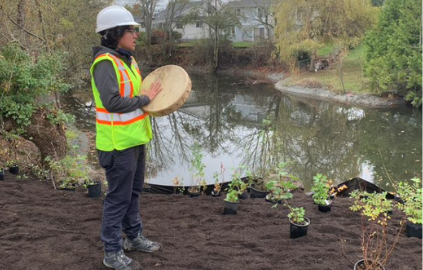ḰEL¸SET (Reay) Creek Remediation Project
Client
Public Services and Procurement Canada (PSPC); Transport Canada
Location
ḰEL¸SET (Reay) Creek, Victoria, BC
Project Duration
July 2020 – March 2021
Background
After receiving runoff from the Victoria International Airport for over 75 years, ḰEL¸SET (Reay) Creek had become heavily contaminated with PAHs and metals, and was in dire need of clean-up and remediation.
Work started in 2020 under the direction of Public Services and Procurement Canada (PSPC), who managed the project on behalf of Transport Canada, as well as coordinated efforts from multiple contractors (QM Environmental, SLR Consulting, Hatfield, and W̱SÁNEĆ Leadership Council).
The remediation included:
- Construction of a creek diversion to maintain a minimum flow for downstream fish;
- Dewatering of the pond;
- Excavation and off-site disposal of contaminated sediment;
- Removal of invasive species;
- Construction of habitat features to create a diverse environment for fish, birds, and other local wildlife; and
- Restoration of the upland disturbed areas.
This project was particularly noteworthy because of Transport Canada and the Town of Sidney’s engagement with the local First Nations throughout the planning and execution of the works. In fact, the W̱SÁNEĆ Leadership Council noted that their inclusion in the project was a “precedent-setting, initial step towards upholding, reaffirming and strengthening W̱SÁNEĆ decision-making within W̱SÁNEĆ territory”.
The W̱SÁNEĆ workers were on-site throughout the project to ensure that:
- Archaeological artifacts, ancestors, and land were treated in a culturally appropriate manner;
- Native plants were selected and planted for health, resilience and sustainability of the creek ecosystem;
- Fish were properly cared for during the draining and remediation of the creek and pond; and,
- Cultural protocols were followed (for example, by performing brushing-off ceremonies before plantings).
Services Provided
Hatfield was initially retained to provide limited administrative support to the W̱SÁNEĆ Leadership Council, but that role quickly expanded to help elevate Indigenous voices in project planning and decisions. By actively listening to questions and concerns from the W̱SÁNEĆ Leadership Council, Hatfield helped bridge the gap between technical project planning and indigenous knowledge of the area. Thanks to efforts made on all sides to nurture the relationship, and a willingness to explore creative solutions to differences in worldview, the project was successful, and everyone involved was extremely happy with the outcome of the remediation efforts.

